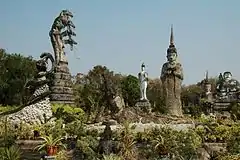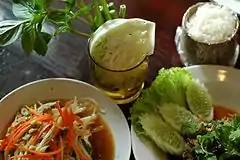Isaan (อีสาน; also Isan, Isarn and even Esarn), Thailand's mainly agricultural northeast region, is an often-overlooked part of the country. It is a multicultural region where Laos, Cambodia and Thailand meet, and has a rich history and great food.
Regions
| Northern Isaan The great Mekong Valley, the national parks of Loei, Ban Chiang, Nong Khai, Wat Phra That Phanom. |
| Central Isaan Also known as the Chi River Basin, the highway from Bangkok ends here in Khon Kaen. |
| Southern Isaan Centred around bustling Nakhon Ratchasima, the Mun River Basin is home to Khao Yai National Park and the beautiful Khmer architecture of Phanom Rung and Phimai. |
Cities
- 🌍 Khon Kaen — centre of the Isaan region, Mittraphap Rd (Rte 2) passes the edge of the town centre
- 🌍 Loei — known for its numerous high hills, mountains and is one of Thailand's vineyards
- 🌍 Nakhon Phanom — bordering Laos along the Mekong
- 🌍 Nakhon Ratchasima (Korat) — the chaotic hub of Isaan, gateway from central Thailand
- 🌍 Nong Khai — gateway to Vientiane and the lovely Mekong Valley
- 🌍 Roi Et — home to the tallest standing Buddha image of the world, Phra Phuttha Rattana Mongkhon
- 🌍 Surin — known for its annual elephant parade and Khmer temples
- 🌍 Ubon Ratchathani — almost always shortened to simply "Ubon", gateway to the Cambodia-Laos border
- 🌍 Udon Thani — also known as "Udon", best known for the archaeological site Ban Chiang
Other destinations
- 🌍 Khao Yai National Park — Thailand's first national park and a UNESCO World Heritage Site
- 🌍 Phanom Rung Historical Park — beautiful Khmer temples and one of the top attractions in Isaan
- 🌍 Phimai Historical Park — some of the most important Khmer architecture in Thailand
Understand
Isaan is a wonderful part of Thailand to visit if you tire of backpacker haunts, one temple after another, or the beaches. The relative isolation and underdevelopment of the area means that Isaan is a good place to get off the beaten track and encounter Thailand's agricultural underpinnings and natural scenery.
Climate
North east Thailand is monsoonal, cool in the dry months of December and January, getting hot and humid in February, March and April, the very wet and tropical during May, June, July and August. Temperatures during the dry can be mid to high 20s °C during the day and as low as 10°C overnight. For much of the rest of the year expect low to mid 30s °C. and high humidity. The air during February, March and April can be very hazy when the main cash crop of sugar is burnt prior to cutting.
Talk
While the national language Thai is used in schools and thus well-understood, the local Isaan language, which is a dialect of Lao, is predominant. Khmer is also widely spoken in areas near the Cambodian border. Although the people you meet in the market are unlikely to speak English, they probably speak more languages than you.
Get in
By car
One of the best ways to enter the region is by car.
By plane
The airports of Khon Kaen, Nakhon Phanom, Roi Et, Sakon Nakhon, Ubon Ratchathani, and Udon Thani can be reached by plane from Bangkok.
By bus
Frequent bus services go everywhere.
By train
Regular train services connect Bangkok with Ubon Ratchathani (via Nakhon Ratchasima, Buriram, Surin, Si Saket and other stations along the way) and Nong Khai (via Khon Kaen, Udon Thani, etc).
Get around
Depending on where you're coming from and where you want to get to, buses, minibuses, songthaews, motorbikes, and bicycles are all good options.
The train system is also a good way to get around, but with only two lines in te region, the number of locations served is limited.
See

There are many attractions in Isaan:
- The surreal statues of Sala Kaew Ku, Nong Khai
- The temple inside the mountain at Chiang Khan
- The temple of beer bottles in Si Saket
- The beautiful Khmer temples in the Phanom Rung Historical Park
- Phimai Historical Park has even more Khmer architecture
- Flora, fauna, and waterfalls in the Khao Yai National Park
Do
Eat

Isaan cuisine shares much in common with Lao cuisine, and is distinctly different from central Thai cooking, although there has been a considerable amount of cross-pollination. Perhaps the best-known Isaan dish is som tam (or tam mak hung in Lao/Isaan), a spicy salad prepared from unripe papayas. While Thais prepare this with dried shrimp, in Isaan the preferred style is with preserved crab (puu) or mudfish, an acquired taste. Other characteristic dishes include roast chicken (kai yaang), sticky rice (khao niaw), fermented pork and rice sausage (sai krok) and a wide variety of cold meat, mint and lemon juice "salads" known as larb.
A word of warning: Isaan food is known, even among Thais, for being fiery hot.
Drink

In addition to the regular standbys, popular drinks in the Isaan region include lao kao, a strong clear spirit distilled from rice, and a home made fermented rice wine called lao hai (เหล้าไห), also known as sato or sa tho (สาโท), made from sticky rice in earthenware jars and drunk directly with a straw. Another popular spirit is Hong Tong, made from distilled molasses (making it a type of arak) and drunk with ice and soda.
Beware that distilling at home is illegal in Thailand, and while this is rarely enforced, it does mean that there is little if any quality control on the local moonshine.
Stay safe
Violence occasionally flares up along the Cambodian border, mainly near Preah Vihear, as Cambodia and Thailand squabble over a small patch of disputed territory. However, as elsewhere in Thailand, Isaan people are Buddhist and are generally happy and friendly people. Many Isaan people are poor and the temptation to overcharge tourists is common as the perception is that 'falang' are wealthy. Compared to the average earnings in Isaan, tourists are wealthy and can probably afford to pay a few extra baht for a tuk tuk ride.
Respect
Compared to much of Thailand, citizens of Isaan tend to communicate in a more direct and straightforward manner. Be mindful of that while you're here.
Go next
- Phitsanulok - a gateway to Northern Thailand
- Preah Vihear - magnificent Khmer temple in Cambodia, easy to reach from Isaan with no visa required
- Vientiane - the once sleepy capital of Laos, becoming more and more discovered